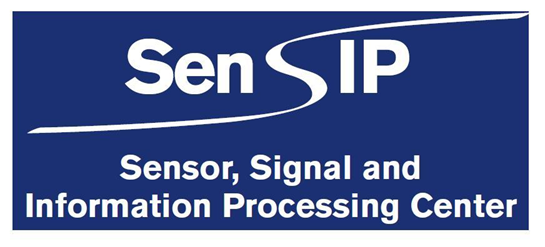
NSF Research Experiences for Teachers (RET) on Sensors and Machine Learning
PI: Andreas Spanias, SenSIP Director Co-PIs: Jennifer Blain Christen, Jean Larson, Mi Yeon Lee
Sample Projects in Sensors and Machine Learning (AI)
SAMPLE PROJECT 1: Machine Learning for Solar Array Fault Detection. Reliability and robust performance are important factors in solar energy systems. Solar arrays often experience faults and underperform due to soiling, droppings, shading due to clouds, ground fault due to manufacturing defects, aging, DC series and parallel arcing, and high-resistance connections formed during manufacturing. Ground faults, arc faults, high-resistance connections, soiling, and partial shadowing need to be addressed. Other fault conditions relate to the inverter performance and affect the AC power output of the array. A solar cell or panel is often modeled as a current source and a diode, with parasitic series and shunt resistance. Predictive models, machine learning, and deep neural networks will be explored for fault detection using SenSIP databases. The teachers will learn the basics of solar array analytics and will form machine learning algorithms and software to detect and classify faults.
Outcome: RET participants will innovate and learn to use machine algorithms for solar array analytics. Teachers will prepare a lesson plan for taking research experiences in machine learning in their classes. RET participants will create a research poster and an IEEE style report.
SAMPLE PROJECT 2: Programming of IoT and Sensor Prototypes. RET participants will be allowed to experiment with prototype sensors and generate data for different conditions. The value of sensor arrays will be explored and RET participants will apply sensor fusion to improve detection. RET participants will be guided to learn how to use simple k-means algorithms for clustering. They will be given sample programs and then guided to create their own program (with help from mentors) for a simple classification task. The tasks of feature extraction will also be part of this project. Before engaging in this project RET participants will be trained to work with user-friendly pre-canned MATLAB and/or Python coding functions and with the aid of graduate assistants, they will learn the basics of calling functions and plotting data. IoT and sensor analytics include diagnosis of machine condition, human body activities, and health monitoring. Each application has its own statistics and features have to be selected carefully.
Outcome: RET participants will innovate and learn to use machine algorithms for sensor systems. Teachers will prepare a lesson plan for taking sensor and machine learning experiences in their classes. RET participants will create a research poster and an IEEE style report.
SAMPLE PROJECT 3: Energy Load Analytics and Forecasting Using Machine Learning. Due to the increase in smart meter usage, houses and commercial buildings can record and transmit energy usage data every fifteen minutes or more. This provides a large amount of individual energy load data. Utility companies analyze this energy data to predict future energy usage, also known as load forecasting. Energy forecasting is used to predict future energy use over the short term (one hour to one week), medium-term (one week to one year), and long term (a year and more). Short- term predictions are helpful in scheduling and allocating energy loads, medium-term predictions help with energy purchasing and maintenance routines, and long-term predictions are used for strategic planning of energy grid development. Due to the large amounts of data involved, many techniques in energy load forecasting involve machine learning algorithms. Machine learning algorithms can detect patterns in energy data, group customers based on energy usage patterns (customer segmentation), and provide short and long- term predictions from previous energy usage. Accurate short-term energy forecasting is essential to improving energy efficiency, reducing blackouts, and enabling smart grid control and analytics. In this project, we will survey several commonly used machine learning forecasting methods and use neural networks and autoregressive models for predicting short-term residential energy usage and load conditions.
Outcome: RET participants will innovate and learn to use neural networks for predicting short-term residential energy usage and load conditions. Teachers will prepare a lesson plan for taking sensor and machine learning experiences in their classes. RET participants will create a research poster and an IEEE style report.
SAMPLE PROJECT 4: Sensors for Mobile Activity Detection
The aim of the project is to use sensors embedded in cellphones to characterize activity. Participants will learn how to characterize data from accelerometer and gyro sensors embedded in mobile phones. Description: Action analysis and gesture recognition from visual or non-visual sensors have seen increasing interest from the industry in recent years. The typical approach for sensor-based activity analysis relies on careful training sets for a few actions of interest. However anthropometric variations cause a significant reduction in performance. In the first phase, the teacher will work on a database consisting of anthropometric variations (age, height, weight). This anonymous database will present unique opportunities to address action recognition algorithm design across anthropometric variations. They will investigate the transition between actions. When humans transition between activities, the signatures often do not appear similar to any expected action, thus causing latency in recognition. This project will use sensor data and optical motion-capture technology at Arts and Media, synced with each other, to enable addressing the transition detection problem in a robust way. Participants will compare estimates of motion from accelerometers and from motion capture cameras, using anonymous databases.
Outcome: RET participants will innovate and learn to use machine learning for activity detection. Teachers will prepare a lesson plan for taking sensor and machine learning experiences in their classes. RET participants will create a research poster and an IEEE style report.
Several additional Machine Learning and Artificial Intelligence Projects will be available for 2021. Descriptions coming soon.
Covid-19 : This year the RET will likely be virtual with online sessions, presentations and machine learning artificial intelligence programming.




